Bedside commodes have definitely made both my life, and my mom’s, a lot simpler, and it was a revelation when we got one. Although it’s called a bedside commode, among other names, it can be used anywhere, even over the toilet to give extra height, and can have multiple functions if you buy the appropriate type.
How does a bedside commode work ? A bedside commode works as a portable toilet without running water. It has a pale, or bucket, under the seat which is used as the toilet part, and which can be removed for emptying and cleaning. Liners can be used for the bucket which are simply removed and placed in the trash, removing the need to clean the pale, or bucket, after use.
Contents Overview & Quicklinks
When should you start using a bedside commode ?
How to set up a commode chair ?
How to keep a commode from tipping ?
How to sit on a bedside commode ?
How to assist someone on a bedside commode ?
How do you use a disposable commode line ?
Tips for bedside commode cleaning
Tips for odor control around the bedside commode
When should you start using a bedside commode ?
In general, bedside commodes are used by patients post surgery, the elderly, or by disabled individuals who need a toilet by the bed, or near to them in another room, due to mobility and safety issues.
It may be that a person cannot stand, and requires a commode next to the bed, which they can slide over onto without standing. In this case, they would use a transfer commode, of the same type a person in a wheelchair would also use.
If a person is not able to slide themselves over, or to stand, they may have a bedside commode, and another person would use a patient lift to place them onto the commode, if it is safe to do so.
A lot of the time a commode is placed by the bed, or in a living area, simply because the user is not able to get to the toilet quickly enough, due to mobility or incontinence issues, and this helps to avoid accidents.
It is often sensible to have a bedside commode next to the bed for the elderly, so they can avoid walks to the bathroom at night.
This helps to reduce falls due to a lack of lighting, or because a person is not fully awake and very stiff from lying in bed.
I know that with my mom, she can be incredibly stiff when she gets up to use the toilet at night, and this can lead to her being both rather slow and somewhat unsteady.
To find out more, you can read this article – “When Should You Start Using A Commode ?”.
Benefits of a bedside commode
The benefits of bedside commodes are many –
- safety
- creates greater independence, freedom and control
- can lead to increased privacy and sense of dignity
- easy and quick access
- wheelchair users may find it easier than a toilet
- comfortable option for bedridden individuals
- can increase user confidence
- height adjustable
- models in all sizes
- low-cost option
- no need for home renovation
- can be placed anywhere in the home
- extremely portable
- models with wheels
- some models have multiple uses
- can be used over an existing toilet
- a safe option after hip or knee replacement surgery
- less stress for caregivers than a conventional toilet
- more sleep for caregivers
To find out more about the positive side to using a bedside commode, –
“19 Benefits Of Bedside Commodes: Making Life Easier For Seniors”
Types of bedside commodes
There are a number of different types of bedside commode, and they are known by quite a few different names, so here are a number of names that the different type of bedside commodes can be referred to as –
- bedside commodes
- commode chairs
- 3-in-1 commodes
- all-in-one commodes
- folding commodes
- portable commodes
- transfer commodes
- rolling commodes
- transport commodes
- shower commodes
- bariatric commodes
The main 4 types of bedside commode and their more currently used names are –
- static bedside/portable commodes
- drop arm bedside commodes
- transport or rolling bedside commodes
- combination shower chair, transport chair and bedside commodes
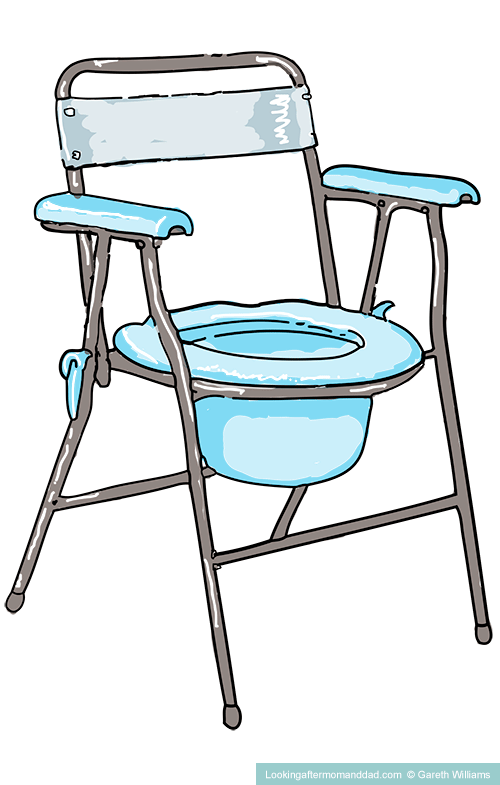
Static folding bedside commode

Static shower chair bedside commode
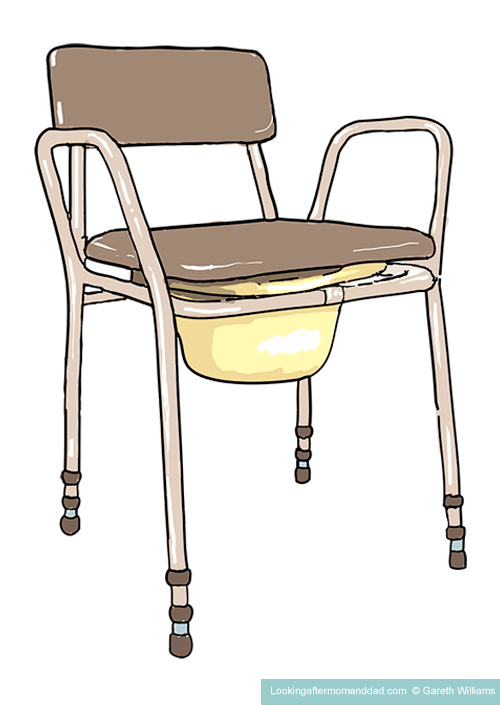
Static stacking bedside commode
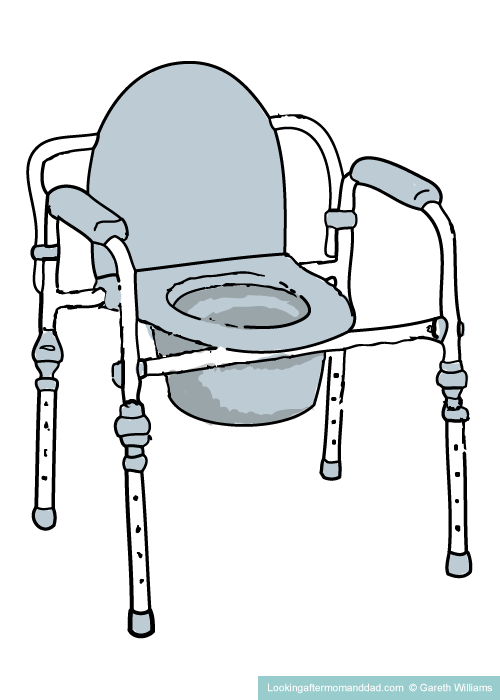
3 in 1 bedside commode
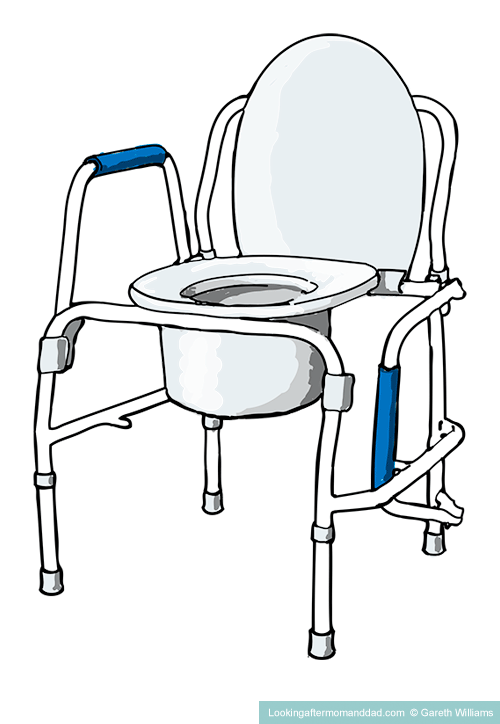
Drop arm bedside commode
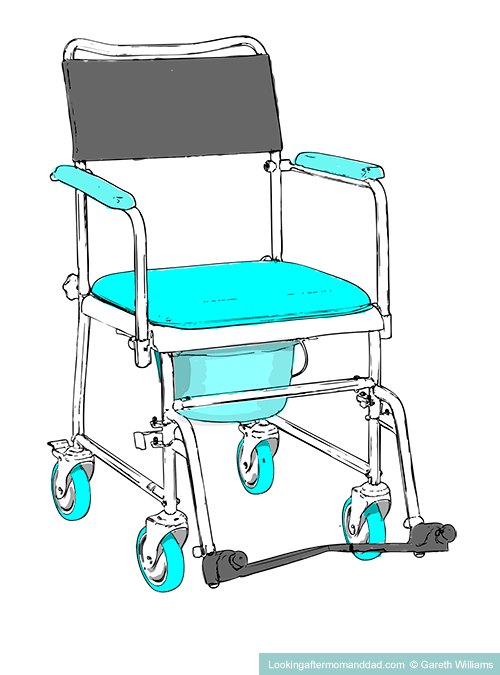
Attendant transport bedside commode
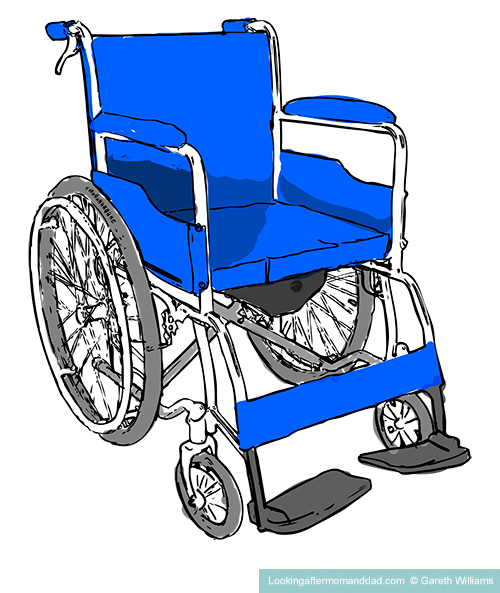
Self-propelling transport bedside commode
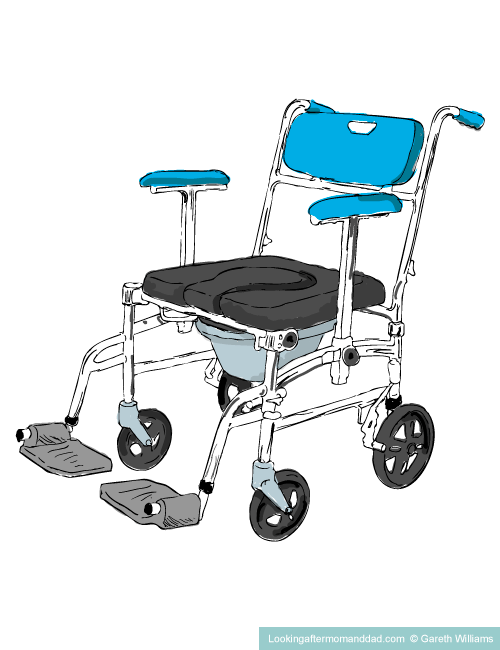
Attendant shower transport bedside commode
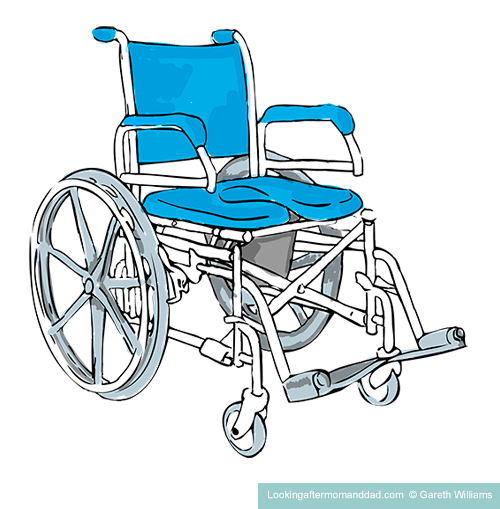
Self-propelling shower transport bedside commode
All these commode chairs can come in –
- lightweight or heavy weight (bariatric) models
- elongated seats
- open or closed front seats
- folding or not folding models
- padded or hard plastic models
- extra wide or normal
- tall or extra tall
You will also find when you look at different models that they may combine a bunch of different features, but they should fall into one of the four main categories that I noted above.
I have a long article which explains more fully the different types of commode chairs, and what makes them suited to particular situations, lots of different models of each type, how to assist someone with using one, how to clean them and how to use them over a toilet – “Bedside Commodes: How To Make The Right Choice ?”.
How to set up a commode chair ?
The most commonly found bedside commode is a static portable bedside commode chair called a 3 in 1, or All in One, bedside commode.
The reason being is that these models of bedside commode can perform at least three basic functions –
- bedside commode
- toilet safety rail
- raised toilet seat
Be warned that not all bedside commodes, and in particular some folding ones, cannot be used over a toilet, and if they are not advertised as being able to be used as such, you may not be able to so.
Some bedside commodes with wheels will fit over toilets as a raised seat, but you must always check the height, and also make sure that there are no obstructions under the commode to make this impossible.
In general the model should say whether, or not, it is possible to use it over a toilet, and one of which height.
The static bedside commodes (without wheels) usually come folded in their packaging box and will require a small amount of effort to assemble.
The following description is for a standard 3 in 1 bedside commode
The commodes typically come folded in such a way that the commode pale holder is generally squashed up against the back side of the bedside commode, and the front legs are folded in against the pale holder.
So to set up the bedside commode you –
- swing the legs out so the back and front legs are upright and standing
- next, you pull up the front bar of the commode pale holder towards you, until the two ends of the horizontal bar can be locked into place in the joints on each of the front legs with their spring-loaded push buttons
- if the back bar which the lid rests against when it is up, is not assembled, pop that it place between the two back legs
- adjust the legs to the height desired by pushing in the spring-loaded
- make sure the legs are all the same height and that they are properly locked in position – the spring-loaded buttons make a clicking sound when they pop out of the holes properly
- if you are using disposable liners, place one in the pail pushing down into the bottom
- any absorbent pads for the liner should be put in there as well
- drop the commode pale into position in the pale holder before you put the seat on
- the toilet seat is usually made of a hard plastic and clips onto the rear bar of the pale holder
- the seat lid clips onto the same bar and the lid and seat can now be pushed down to cover the commode pale
- position the commode where you wish it to be used and remove any clutter which can cause the user to trip
- if you are not using disposable liners, it’s a good idea to pour about 3 inches of water into the commode bucket to help with odor control and cleaning
If the commode frame has come assembled, you just need to –
- place disposable liners in the pale if you are using them
- don’t forget the absorbent pads in the liner if you are using one
- place the pale in its holder
- clip on the seat and lid to the bar which has the pale holder attached to it
- adjust the height of the legs as desired using the spring-loaded push buttons
- make sure the buttons pop out fully – they will make a clicking sound
- make sure the legs are all the same height to avoid accidents
- place the commode where you wish to use it
- if you are not using disposable liners, you will want to now pour about 3 inches of water into the commode bucket to help with odor control and cleaning
How to keep a commode from tipping ?
To stop a bedside commode from tipping, there are really only a few solutions.
You can wedge the commode chair into a confined space without wiggle or tipping room –
- in the corner of the room against the walls and some furniture
- or between the bed and the corner of the room
- lastly, do remove any clutter that could cause your loved one to trip
There is a commode chair – the Derby Corner Commode Chair – which is built so that the user’s back is facing the corner.
But the best way to avoid tipping is to make sure that your loved one knows how to sit down on a commode without it tipping, and that you know how to assist them in doing so.
Should you wish to find out more, here’s another article about that, “How To Keep A Bedside Commode From Tipping Over ?”
How to sit on a bedside commode
It can be very useful to use a walker when backing up to sit down on a bedside commode.
It is recommended in hospitals to use a walker as an aid to sitting after hip and knee replacement surgeries.
The walker just gives that extra bit of stability as the person reaches back to find the arm of the commode.
I would suggest that for elderly loved ones who have mobility issues, it is very helpful, and it can also boost their confidence to have some extra support as they are moving backwards.
For sitting on a bedside commode, your loved one should learn to –
- with the aid of a walker, to back up to the bedside commode
- stop once they feel the commode frame touching lightly against the back of their legs
- to lower any clothing before they attempt to sit
- reach back and take hold of the armrests, one arm at a time
- to sit down on the commode only once they have the armrests firmly in their grip on both sides
Your loved one should only be doing this by on their own, if they are able to do so without risking injury.
While you are looking for bedside commodes, there is lots more that you can do to make your bathroom a safer place for seniors, or anyone else with mobility issues.
To find out all the different things you can do, to have an instant impact on bathroom safety, take a look here, “54 Bathroom Safety Tips For Seniors – A Helpful Guide”.
How to assist someone on a bedside commode
How to help your loved one if they can’t clean themselves –
- if you know before you buy the commode chair that you are going to be assisting your loved one with cleaning, you should consider a drop arm bedside commode
- the drop arm models allow you to raise the armrests so that you can get access at the sides of the user to give help
- before you start, make sure you have all the provisions you need to hand and easily within reach
- The most basic items will be gloves, toilet paper and wipes
- put on the gloves before helping your loved one
- always say how you are going to proceed stage by stage before you act, so your loved one understands what is happening
- speak clearly and try not to move too quickly for the person you’re helping, and the older they are, the slower you should go
- first assist your loved one to stand and to hold onto the walker for support
- help wipe, or wipe, your loved one with either the toilet paper or wet wipes
- in the case of helping women, it’s important to clean them from the front to the back to help to prevent UTI’s
- after cleaning, your loved one should be gently dried with a soft towel
- once your loved one is dry, help them to put any clothes back on
- help your loved one back into the bed or wherever they wish to sit etc
- make sure to dispose of all the waste into the outside trash, so odors don’t build up around the commode chair
- dispose of the gloves and thoroughly wash your hands with soap and water
Self Cleaning bedside commodes
Other than using a commode over a toilet, the easiest way of eliminating a lot of cleaning work is to use disposable commode liners.
The liners are placed in and over the pale, and can come with absorbent pads or powders – you will want these if you don’t want to have to deal with tipping any urine down the toilet.
The pads or powders have gelling agents which soak up any liquid in a matter of seconds.
Popular brands of disposable commode liners in the US
Liners which come with absorbent pads to soak up liquids –
- Bearals
- Better Moments
- CareBag
- Meddacs
- Medline
- Nurture
- TidyCare
- Vakly
- Vive
Liners with absorbent powder –
- Carex
- Medustry
Liners with a gelling agent –
- CleanWaste Sani Bag
Liners which can be bought without absorbent elements –
- Bearals
- Better Moments
- Meddacs
- Nurture
- Sani Care
- TidyCare
- Vackly
- Vive
Popular brands of disposable commode liners in the UK
Liners which come with absorbent pads to soak up liquids –
- Abena Abri-bag
- Age Co
- CareBag
- Dr Helewa
- Healfty
- Medline
- Remylady
- Reynard
- TidyCare
- Vive
Liners with absorbent powder –
- Carex
- Medustry
Liners with a gelling agent –
- CleanWaste Sani Bag
Liners which can be bought without absorbent elements –
- Meddacs
- Tidy Care
- Vive
If you want to learn a lot more about disposable commodes liners, which brands sell bulk amounts, how to make homemade commode liners, the best biodegradable methods and lots more, you can read my article “How to dispose of commode liners”.
My mom uses Carebag commode liners if she is not using her bedside commode as a raised toilet seat and has been perfectly happy with those.
Never flush these liners down the toilet as they will block it.
Dispose of the bags in your landfill trash, as that is what they are designed for.
How do you use a disposable commode liner ?
To use a disposable commode liner with an absorbent element –
- place the commode liner over the commode pale and push the interior of the liner down to the bottom of the pail
- take an absorbent pad or powder put it into the bottom of the liner, if you are using one
- place the pail in the holder under the commode seat ready for use
- as soon the commode liner has been used, remove it and pull the draw strings up and make a knot
- if the liner is the type with a sticky seal, stick that down as well
- if the liner is not the type with a sticky seal, you can make a knot with the top of the liner
- throw out the liner immediately in the outside trash destined for landfill
To use a disposable liner without an absorbent element –
- place the liner over the pail and push it down to the bottom of the pale
- as soon as the liner has been used, keeping the liner in the bucket, tip the contents of the liner down the toilet
- rinse the liner if you wish, and tip the contents down the toilet again
- remove the liner from the bucket and tie off the top of the used empty liner
- throw the liner away in the outside trash destined for landfill
Tips for bedside commode cleaning
Before you start cleaning, get prepared with the right equipment and clothes
Tip # 1
You must first prepare yourself for cleaning – gloves and overalls, so you don’t get poop and urine on your clothes.
Tip # 2
You will need the right cleaning products for the job. You require a cleaner and a disinfectant, or a combination of the two.
- The most popular cleaners used across the caregiver forums, and I have found them to be very good as well, are –
- Lysol cleaner and disinfectant
- Pine-Sol cleaner and disinfectant
- OdoBan
- Dettol
- Method toilet cleaner
- White Vinegar – this cleans, disinfects, removes odors, and can even fungi
Tip # 3
As well as cleaning the commode and commode bucket, you will eventually have to deal with spills, and sometimes on carpeted areas.
A lot of caregivers use enzymatic cleaners (often used for the feces and urine of pets, so they are easy to find in pet stores, or online as well) such as –
- Anti Icky Poo
- Natures Miracle
Tip # 4
For a lot of people, the odors involved in the cleaning of a commode, and especially the bucket, are the most difficult part of the job. So be prepared for that.
Quite a number of people wear a mask – like a surgical or dust mask, and they literally scent it with an oil, which is quite commonly done by surgeons when they are aware that a surgery may be rather smelly.
Oils used include –
- oil of clove
- oil of lavender
- peppermint oil
- vanilla essence
Tip # 5
Other caregivers instead of a mask will smear a mustache of –
- vicks
- mentholatum
- horse linament
Tip # 6
If you don’t like masks or a mustache, quite a few caregivers suck strong mints or menthol sweets and hold them high in their palette, drawing their breath up over the sweet to cover any bad smells.
What’s the best way to clean the commode bucket or pale ?
Tip # 7
If you are not using disposable liners or a homemade version, and are using the pale and emptying it, you should be cleaning it every time it has been used.
Do not let it build up, as your loved one will be constantly breathing in the odors, and this is not good for the health.
Tip # 8
Do not rely on the pale handle when you are carrying it to the bathroom to empty the pale, always place one hand underneath, taking most of the weight.
I have had pale handles come off on a number of times, and thankfully there was nothing in there at the time, but I don’t want to imagine what it would have been like if there had been.
Tip # 9
To clean the bucket, just tip the contents down the toilet and then rinse with water before using a cleaner to get out any material, and rinse again.
After the first rinse, use a disinfectant and give it a good scrub and rinse it out again.
For cleaners and disinfectants you can use the combination products like Lysol, Pine-Sol or OdoBan, but you can also use the enzymatic cleaners that I mentioned earlier, like Anti Icky Poo or Natures Miracle.
Tip # 10
If your commode pale is made of plastic, it is a good idea to have more than one. This is because plastic absorbs any odors, so when a pale has been used – without a disposable commode liner – it is a good idea to empty it and give it a first cleaning, before soaking it in water and bleach for a few hours to really get the bacteria out of it which will cause all the odors.
While this pale is soaking for a few hours, you can replace it with the second pale if the commode is need by your loved one.
Tip # 11
If you can find a ceramic or metal commode pale that fits your commode, you will find that it will not absorb the odors of the urine and feces as plastic will eventually do.
Tip # 12
In cases where you are not using disposable commode liners, it will make cleaning of the commode pale a lot easier, if you put some water into the pale – a quart of water or 2 -3 inches is about right.
The water will make cleaning that bit easier, and it makes tipping out the contents much simpler.
People also put some water in, as it covers any feces immediately and inhibits the release of the unpleasant odors.
To clean a frame or commode
Tip # 13
You will want to clean, rinse, disinfect and rinse the commode again.
If you have a combination cleaner and disinfectant, just remember the goal of the first cleaning is to remove any matter that is stuck on, and the second passage over the surfaces is to disinfect, so do go twice if you can.
Tip # 14
Start by removing the armrests, the seat, the lid and the splash guard – clean each one with a non-abrasive cleaner and then rinse them off thoroughly – or with a cleaner and disinfectant combined, but it needs to be non-abrasive.
Tip # 15
You need to clean the armrests and seat the most, and they are the areas where your loved one’s skin has the greatest contact, and it will help reduce the chance of infections.
Tip # 16
The underside of the seat, the splash guard and the frame immediately next to them, will be the areas which get covered with urine and feces, so these areas will have the most matter that has to be cleaned off before trying to disinfect them.
Tip # 17
The first passage of cleaning and then rinsing is done to remove any matter which is stuck on the commode, so really give it a good scrub.
The reason that your cleaner must be non-abrasive is so as not to degrade the surface of the plastic, as this would eventually trap urine and feces in it if it became rough, and could absorb bacteria.
Tip # 18
Rinse the armrests, seat, splash guard and lid once they have been washed with cleaner and check that all the poop etc. is gone.
Tip # 19
Go over the same parts again with the disinfectant.
Tip # 20
After the disinfectant, you can rinse and dry the different parts that you have removed and washed.
Tip # 21
Clean the whole frame of the chair and remove any matter – you can always rub it down with hot water first to help soften matter up, before you attack it with the non-abrasive cleaner.
Tip # 22
Rinse the frame and the pass over it all again with disinfectant, and then rinse again before drying.
Tip # 23
You must regularly check the plastic of the seat for any cracks to avoid any splitting, which could lead to an accident. Anything with cracks should be replaced.
Tip # 24
Make sure that there is no rust in the joints of the commode frame, and if there are plastic joints, have a good look to make sure they are not cracking.
Tip # 25
Be sure to check the ferrules – the rubber tips of the legs of a bedside commode – for splitting, as when they split they no longer grip the floor as the metal will come through, and can then skid across any floor which is not carpeted.
I had a very nasty fall when the tips of my crutches split and the metal of my crutch skidded on the shiny floor I was walking on.
With a commode when someone sits down, or stands up, it could skid backwards if not against a wall, causing an injury.
The ferrule does have a metal washer at the bottom of the leg to stop the tubing cutting through the ferrule, but as in my case with my crutches, the ferrule still split.
You can easily find and buy replacement “ferrules” online.
Tip # 26
Once you have finished cleaning and checking everything, remove the gloves and put them in the trash, and then wash your hands with soap thoroughly.
Tips for odor control around the bedside commode
The major drawback with bedside commodes being used in any room, other than the bathroom, is the problem of the smells.
Any odor with be absorbed by the surrounding materials, so it’s vital that you know how to reduce these to a maximum for your loved one, especially if it is their bedroom.
Tip # 27
If you can afford it, have a workman put in an extractor fan (just like the ones in bathrooms) in the wall just above the bedside commode, which you can easily turn on and off. This will remove the majority of smells and is much better for the health of the person in the room.
Tip # 28
If the commode chair is in the bedroom, spray the mattress with Lysol, OdoBan or Dettol spray to remove odors. You don’t need to wipe down after using these sprays, but you do have to vacate the room if you are using Lysol as it is not meant to breathed in, and takes 45 minutes to dissipate in the air.
Tip # 29
Spray curtains and any other soft furnishings with Lysol, OdoBan or Dettol sprays, and vacate the room for 45 minutes if it is Lysol that you are using.
Tip # 30
Open the windows as much as you can if you don’t have an extractor fan in the room.
Tip # 31
I think this goes without saying, but empty the pale as quickly as you can after every use. The sooner it is done, the less time the odors have to build up.
Tip # 32
After use, if you are not using disposable commode liners, put the lid on the commode pale immediately to stop the odors from escaping into the room.
Tip # 33
Again, if you are not using disposable commode liners, and you are tipping the waste down the toilet, put the lid on it as you are carrying the pale to the toilet or the smell will get everywhere.
Tip # 34
As well as spraying with Lysol etc. you can also wash the curtains and bed covers rather more frequently than you would ordinarily, as this will help to remove odors – white vinegar in the wash can also help to remove odors more efficiently.
Tip # 35
You can also try using air purifying filters such as HEPA filters.
Tip # 36
You can also use an ionizer to purify the air, but don’t use it while anyone is in the room.
Tip # 37
Always remove fresh trash immediately from the room, such as wipes and toilet paper, never leave them sitting in the trash cans in the room.
Tip # 38
Toilet paper should be flushed away, but do not put wipes down the toilet.
Tip # 39
Wipes should be thrown into the outside landfill trash cans.
Tip # 40
Don’t put the products used for clean up into any room trash bins, as they will just absorb the smell, and it will stay there long after.
Tip # 41
If you forget, and you use the trash can in the room, disinfect it and sprinkle some baking soda into the bottom as this will absorb the odors.
Tip # 42
Don’t forget to clean the area under the commode bucket, and if you can, put some plastic down on the area under the bucket.
It can just be removed if you have a spill, and make cleaning much easier as well as odor removal.
Tips for odor control of the bedside commode pail
If you are not using disposable commode liners, you will have quite a lot more odors to contend with as you have to take the pale to the bathroom and empty it.
Tip # 43
The first step you can take is to put 3 inches or about a quart of water in the commode pale every time before it is used.
The feces will be trapped under the water and the odors will have a far harder time escaping into the air.
Tip # 44
As well as the 3 inches of water, you can put a spritz of a product called Poo Pourri into the water in the commode pale as well.
This forms an oily layer on the water, making it even harder for the odor to escape, and has a perfumed scent as well, providing a double barrier.
Tip # 45
Other products that people add to the water include –
- lavender essential oil
- peppermint essential oil
- listerine mouthwash
Tip # 46
Whatever you do, DO NOT PUT BLEACH OR CLEANING PRODUCTS IN THE WATER IN THE COMMODE PALE AS THEY CAN SPLASH UP AND CAUSE NASTY SKIN IRRITATIONS ON YOUR LOVED ONE’S PRIVATE PARTS.
BLEACH WILL ALSO COMBINE WITH URINE TO FORM CHLORINE GAS WHICH IS VERY BAD FOR THE LUNGS.
SO NO BLEACH, OR CLEANING PRODUCTS, IN THE WATER IN THE PALE BEFORE USE !!
How to set up a bedside commode over a toilet
Bedside commodes can also be used over a toilet bowl as a raised toilet seat. This is of course only of use if your elderly loved one can get to the bathroom.
If it is the case that your loved one can’t walk all the way to the bathroom, or can’t get there quickly enough, there is also the option of a transport bedside commode with 5″ casters.
So, when there is time you can remove the commode pale, and wheel your loved one into the bathroom, and position the commode over the toilet.
Either with a static bedside commode, or with a transport commode, it is a great option to have as
- it will give your loved one more privacy
- the odors will stay in the bathroom
- you can simply flush the toilet afterwards, eliminating almost any need for cleaning
My mom has never had the splash guard in place when she uses the commode over the toilet, and as the cleaner I can attest to the fact that it has not been necessary.
In most cases, the commode seat is only a max of 3-6 inches above the toilet, and it isn’t necessary.
So, to set up a commode over a toilet you will –
- take out the commode pale
- either put the toilet seat and lid in the upright position, or remove them altogether
- set the commode legs to the right height
- to change the length of a commode leg you push in the spring-loaded buttons, and either pull the leg down to lengthen it, or push it up to shorten it
- all the legs must be the same height for safety, and although that sounds stupid, you would not believe the number of times they looked the same length but were not, when I was doing this task
- take care that all the spring-loaded buttons have properly popped out of the holes on the legs – they will make a clicking sound when they pop out and lock into position
- don’t make it too high as your loved one’s feet should always be on the floor when they are seated, otherwise this can lead to accidents when they try to stand up from the commode
- when the legs are at the correct height position, the commode over the toilet
- the splash guard slots in where the pale normally goes
- now put down the commode chair seat, and it is ready to be used
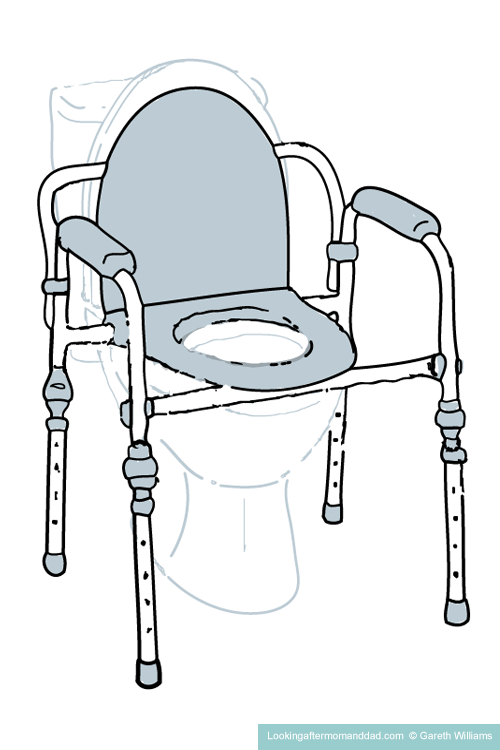
3 in 1 commode installed over a toilet
I’m Gareth, the author and owner of Looking After Mom and Dad.com
I have been a caregiver for over 10 yrs and share all my tips here.

